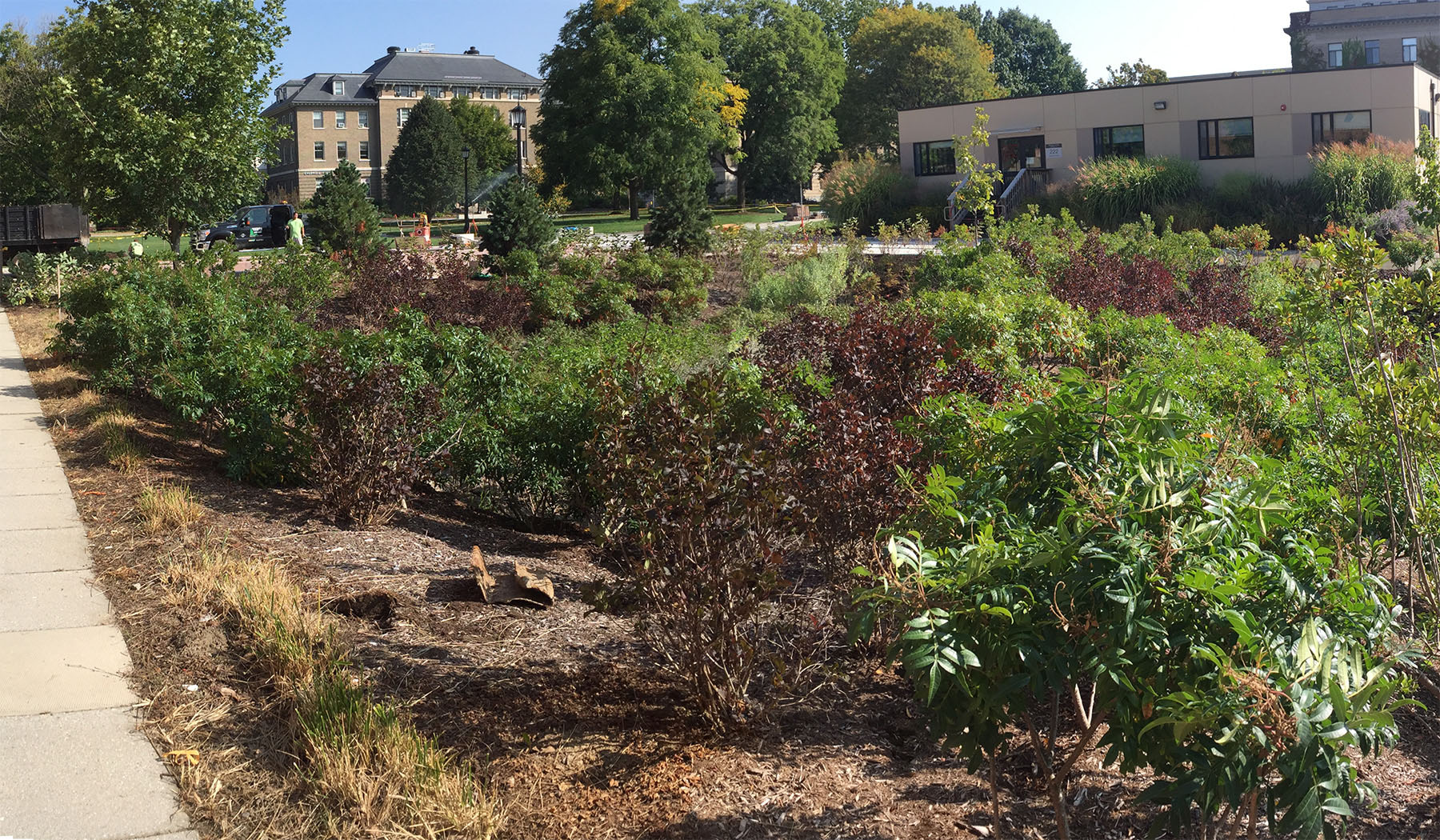![]()
Ag Quad Detention Basins
Sustainable Landscapes Trail at Cornell University
As part of the 2017 Ag Quad Landscape Revitalization project, many walkways were widened and two new plazas were created in the Cornell Agricultural Quad, increasing the quantity of impervious surface and resultant stormwater runoff. State water quality regulations and municipal permitting required that this increase in stormwater runoff be treated to protect water quality and minimize downstream erosion and flooding in adjacent waterways (e.g. Fall Creek).
Return to Sustainable Landscape Trail Sites Homepage
This system of bioretention basins incorporates designed soils with high infiltration that filter water and trap pollutants along with carefully selected plant materials that slow the runoff and take it up during transpiration.

Ag Quad bioswale
Why is this site sustainable?
By directing stormwater runoff into the bioretention basins, the water quality is improved by filtering through the plant rooting zone and soil, and much of the water is used by the plants or infiltrates into the groundwater, minimizing the additional water reaching Fall Creek as untreated stormwater runoff. The detention basins:
- Reduce storm water runoff from the plaza between Kennedy and Roberts Hall and Ag Quad walkways into storm drains that empty into Fall Creek and eventually Cayuga Lake
- Allow precipitation and runoff to infiltrate into the landscape, recharging ground water
- Filter polluted runoff through the soil and root zone
- Support diverse vegetation that makes use of precipitation and runoff
- Provide habitat for insects and pollinators
- Serve as a teaching landscape to learn about nature-based solutions and plants appropriate for this use
Bioretention Basin Construction and Function
In the summer of 2017, a series of connected basins were excavated approximately 4.5 feet deep, each about 1,200 SF in area, stepping down the slope from the Ag Quad along Kennedy Hall. A 12” bed of drainage stone was placed at the bottom of the excavations along with a wrapped perforated pipe to prevent water from sitting in the bottom of the basins too long and creating anaerobic conditions. 24” of bioretention soil – a sandy loam soil - was placed on top of this layer to serve both as a planting soil and a filter for incoming runoff. Runoff enters the basins as surface flow from the adjacent walks and through a subsurface pipe that collects water from the plaza between Kennedy and Roberts Hall.
Shrub species were specifically chosen to plant in these basins for their tolerance to winter salt, and both wet and dry soil conditions. The following plants were installed based on the general planting plan below. The letters in parentheses after the plant name correspond to the symbols in the planting plan.
- Baccharis halimifolia, Groundsel-Bush (BH)
- Cornus sanguinea, Red-twigged Dogwood (CSF)
- Morella pensylvanica, Northern Bayberry (MP)
- Physocarpus opulifolius ‘Diablo’, Diablo Ninebark (DKB)
- Rhus coppalina ‘Prairie Flame’, Prairie Flame Shining Sumac (RPF)
- Salix repens, Creeping Willow (SR)
- Sorbaria sorbifolia ‘Sem’, Sem Falsespirea (SSS)
This Ag Quad Bioretention Basins provide a demonstration of green infrastructure (also known as nature-based solutions), and serves as a practical model for similar community, commercial and institutional settings. It can be scaled to larger or smaller sites by adjusting the size and number of basins to provide stormwater run-off reduction, storage and infiltration into the ground.
Plant species were selected that are suitable for both full sun and shady as well as wet and dry conditions.
- Danthonia spicata and Danthonia compressa (poverty oat grass) are dominant in the planting. Penstemon hirsutus is also widely planted.
- The sun loving, dry site forbs include Phlox subulata and Antennaria plantaginafolia..
- Bluets, Hedyotis caerulea add color to the mix.
